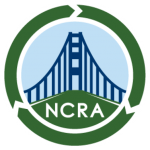REDEMPTION OPERATOR SURVEY #1
Conducted by Doug Brooms in collaboration with Dan Knapp, Ph.D., Urban Ore, Inc.
California has lost about 35% of its redemption centers in the last four years. According to CalRecycle, the State agency that oversees recycling, during the past 12 months since April 2016, another 140 collection centers have closed. Now there are only 1,692 statewide. In Alameda County 28 redemption centers remain, of which 6 are in Oakland. The erosion of businesses and jobs, the drop in resource recovery and the inconveniences to consumers of having fewer redemption centers are no longer tolerable.
Nonprofit recycling advocacy organization, Californians Against Waste, has requested a survey of Bay Area recycling centers that return Container Redemption Value (CRV) deposits to the public. They are working to understand the impacts both on businesses and on local communities. They will use the information gathered first to understand the impacts, and then to inform decision-makers in Sacramento who are working on reversing these closures. The information will also be used to inform the public. We want to make each interview into a very short informative story that people can relate to.
Here is the first interview:
Community Conservation Centers (CCC) operates a recycling buy-back and drop-off facility situated on a 98,000 square foot parcel owned by the City of Berkeley at Gilman and 2nd Street. (Map) The multifaceted recycling enterprise encompasses CRV redemption and buy-back in one quadrant, an adjacent zone for convenient drop-offs for a dozen recyclable categories, and the Ecology Center Curbside Recycling office and yard to the north. The processing operations for container and paper sorting and baling occur in the rear of the property. Tall stacks of bales abound – compacted aluminum cans, plastic bottles, mixed paper, cardboard and large open metal boxes of glass.
Drive-in customers wait in queue to unload their CRV segregated cans and plastic bottles directly into a hopper for a short conveyor belt ride up and over into a rectangular metal basket sitting on a scale. An adjacent buy-back weigh station is for non-CRV items including paper, cardboard and metal and glass bottles segregated into clear, green and brown. Walk-in customers empty their goods into black 55-gallon barrels. The various weights, rates and amounts are printed on a receipt which customers redeem for cash at an open window. The supply of customers has gradually increased. The mix of occasional casual redeemers to regular dependent redeemers is about 50/50.
The breakdown in plastics received is about 30% #1 PET bottles, 30% #2 HDPE bottles, 30% consumer clam shells and containers, and 10% industrial crates, tubs and buckets. There is no market for food contaminated plastics, which are disposed of at a loss. This year, China’s National Sword has replaced its Green Fence policy, demanding higher quality bales with no more than 2% contamination, which is not a problem with CCC.
CCC first noticed a downturn in scrap values in 2013. Revenues have not been sustainable, but operations remain viable using reserve account funds and support from the City of Berkeley. Challenges include increasing overhead, transportation costs, regulations and maintenance of an aging facility. Stormwater regulators have imposed compliance requirements, adding to costs. If scrap values continue their slide, the outlook would not be good, but there are no eminent thoughts of closing the recycling facility
CCC does not have any residential neighbors and has not experienced complaints. Suggestions for improving the bottle bill include adding CRV redemption for milk, liquor and wine bottles, and having supermarkets to pay for (buyback) all of the CRV plastics they sell.
# # #
